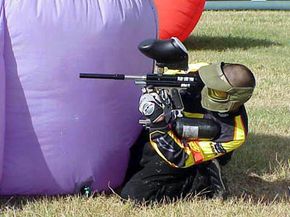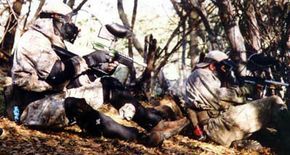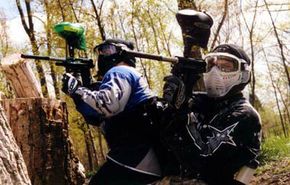The most basic piece of paintball equipment is the paintball itself. Just as in tennis or soccer, the ball is the central element of a paintball game. But unlike these older games, paintball has dozens, often hundreds, of "balls" in play at any one time. As the name implies, these balls are actually tiny containers of paint.
Paintballs have an incredibly simple construction. They're actually a lot like gel-cap pills, or bath-oil beads. They consist of a glob of colored liquid encased in a gelatin capsule. The "paint," which comes in many colors, is non-toxic, biodegradable and water soluble (so it will wash off skin and clothing).
Basically, a paintball is like a small water balloon, weighing only a few grams and measuring only 0.68 inches (1.7 cm) in diameter. The capsule holds up if you handle it or drop it from a short distance. When you shoot a paintball from a gun, however, it bursts on impact and leaves a 6-inch (13-cm) splatter of paint.
The job of the paintball gun, sometimes called a marker, is to get the paintball moving at a high rate of speed. In the basic gun, the propulsion system is compressed gas. This gas, which can be compressed carbon dioxide (CO2), nitrogen (N2) or ordinary air, is stored in small cartridges or larger tanks that can be attached to the gun. The gun is also attached to a hopper, which holds the paintballs.
Different guns have different firing systems, but the basic idea in all of them is the same. The gun is cocked in some way so that a paintball can fall out of the hopper and enter the gun's barrel. Then a small burst of compressed gas is released into the barrel, just behind the paintball. The compressed gas pushes the paintball from behind with much greater force than the air on the other side of the paintball, so the paintball is propelled forward.
In order to make the game safe, the power of paintball guns is strictly regulated. Guns in play are adjusted so that the top speed of the fired paintball is 300 feet (91 m) per second. A paintball moving at this speed is unlikely to cause serious injury if it hits your skin, though it will sting and may leave a bruise. Also, since wind resistance starts slowing the paintball down as soon as it leaves the gun, it has a reduced impact when fired from a greater distance. Speeding paintballs can cause serious injury to the eyes or ears, so paintball players always wear head protection.
The relatively slow projectile speed significantly limits the range of paintball fire: The paintball will fall to the ground in a much shorter distance than a faster projectile, such as a bullet. For this reason, firing a paintball gun is a sort of hybrid between firing a gun and throwing a ball. To hit somebody at a distance, the shooter has to tilt the gun up a little bit, so the paintball flies up in the air in an arc, like a football, and comes down on the target.
There are a variety of gun designs on the market, each with a slightly different system, but they are all based on the same principles. In the next section, we'll find out how guns generally work by examining the specific mechanism in a basic "pump" gun, a design that dominated paintball in the game's early days.




